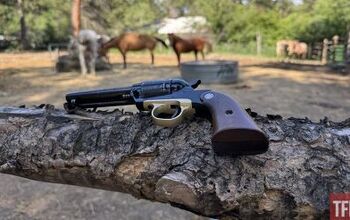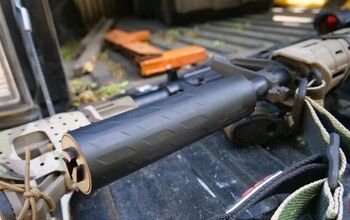What Is 300 Blackout Good For?

Since its inception in 2009 and subsequent SAAMI approval in 2011, the 300 Blackout cartridge has had a somewhat polarizing effect on the firearms community. Some shooters see the round as a do-it-all tactical solution, while others say they don’t get the point. This is one of those arguments that people shouldn’t put too much time or effort into, as both sides of the debate are right and wrong. Many have the wrong impression about what 300BLK was developed to address, seeing it as a challenger to 5.56x45mm NATO. This assertion tends to goad the 5.56 NATO crowd into defending old faithful, pointing out that velocity, trajectory, and terminal performance favor the readily available, relatively inexpensive round proven effective globally since the Vietnam War. Like most discourse, the answer lies somewhere in the middle, recognizing that 300BLK was developed for a particular purpose, and is a very versatile round that can provide mission-specific benefits.
The Short History
300 Blackout was initially developed by Advanced Armament Company (AAC) at the request of the United States Military to replace the 9mm submachine gun and personal defense weapon (PDW) with a more formidable and versatile weapon system for close-quarters and suppressed operations. To my knowledge, 300BLK has subsequently found its way into military use via the Low-Visibility Assault Weapon (LVAW) program and the SOCOM PDW program, both based on the SIG SAUER MCX Rattler platform.
Subsonic
When comparing subsonic ammunition by caliber, the velocity range is similar from cartridge to cartridge. However, the common subsonic 220gr 300BLK round dominates in mass over the most common subsonic 9mm 147gr and offers a significantly better trajectory and terminal performance due to its shape and ballistic coefficient. For example, a Sierra 9mm 147gr JHP projectile has a G1 coefficient of .157, whereas a Sierra .30 caliber 220gr Matchking boasts a G1 coefficient of .629. That’s a pretty big difference.
Additionally, subsonic 300BLK offers excellent sound reduction when coupled with a suppressor, almost achieving that highly exaggerated Hollywood depiction of silenced firearms having little to no audible report. This is all possible without increasing the overall size of the platform, which I’ll demonstrate in a side-by-side comparison between the SIG Rattler and the new Springfield Armory Kuna. Does this all add up to 9mm submachine guns and PDWs becoming obsolete? Hardly at all, especially in the civilian market, where 9mm is more readily available and considerably less expensive. For military applications, however, where cost and availability are not issues, I struggle to find a scenario where I would choose a 9mm over a 300BLK.
Supersonic
The disparity in projectile weight between supersonic 300 Blackout and 9mm is smaller, with 300BLK weighing between 110gr and 150gr, and 9mm generally from 115gr to 124gr. However, this is where 300BLK shines in ballistic coefficient again, and in velocity. For example, Hornady Critical Duty 124gr 9mm only achieves a muzzle velocity slightly above supersonic, right around 1200 FPS with a G1 coefficient of .165. In comparison, my SIG Rattler registers around 2000 FPS with Hornady Black 110gr V-Max and a coefficient of .290.
Did AAC succeed in developing a cartridge that exceeds the performance of 9mm submachine guns while providing excellent sound suppression from a similar-sized platform? The answer is resoundingly yes. So why all the fuss?
5.56 NATO
300 Blackout was also designed to be loaded in STANAG magazines and deployed in the AR-15 platform, which has likely fueled the obsession with comparing it to 5.56 NATO. You won’t hear much talk about subsonic 5.56 NATO for two reasons. First, it will not reliably cycle the action on a semi-automatic rifle. Second, the 5.56 NATO round relies on velocity to deliver terminal performance through tumbling, expansion, and fragmentation, which can not be achieved with standard ammunition at subsonic velocities. Because of its rare use application and impracticality, we’ll stick to supersonic comparisons regarding 5.56 NATO.
This is where the debate typically takes a turn for crazy town, as we end up comparing apples to oranges and arguing over the taste test. 5.56 NATO is a proven and capable round for its relatively small size and weight when coupled with appropriate velocity. Determining that velocity is a matter of cartridge selection, as different projectiles display varying characteristics at speed. This isn’t to say that .30 caliber projectiles derive no benefit from higher velocities because they do. Velocity is just less of a factor, as larger calibers typically take advantage of additional mass and energy on target.
So, is .300 Blackout better?
Herein lies the folly of making comparisons that were not meant to be made. 300 Blackout was designed to excel when shot suppressed through shorter weapon systems, and it achieved just that. A popular length for longer 300BLK platforms is 9”, shorter than the 10.3” MK18. However, 110gr V-Max out of the 5.5” barrel of a SIG Rattler reaches its minimum expansion velocity of 1600FPS at around 185 yards, and the larger projectile will likely continue to demonstrate excellent performance downrange, delivering approximately 470 ft-lbs on target at 300 yards.
A 77gr 5.56 NATO round from a 10.3” barrel with a muzzle velocity of approximately 2400 FPS reaches its minimum expansion velocity of 2100 FPS by around 150 yards, and despite its diminutive size, I doubt anyone wants to find themselves in its path beyond that. In fact, this round will carry considerably more energy than my 110gr V-Max out of a 5.5” barrel.
So, what is 300 Blackout good for? Aside from achieving its goal of providing better ballistic performance than a 9mm submachine gun in a package that responds well to suppression and maintains a compact footprint, what can it do that 5.56 NATO can not? The answer is simple. 300BLK allows you to go with a significantly shorter barrel and a more discreetly sized firearm without heavily sacrificing short to medium range ballistics. If we compare 5.56 NATO at such short lengths, it would be a hot mess, with stabilization issues and poor ballistic performance. It would let out an extremely concussive blast and enough of a fireball to classify it as a flamethrower. Suppressing it would hardly be effective, and additional concerns would include suppressor abuse as unburnt powder ignites inside, and potentially unstable rounds causing a baffle strike.
300 Blackout, on the other hand, burns powder more quickly and will stabilize fine in barrels as short as those found on the Rattler. Due to the faster-burning powder, velocity takes much less of a hit in shorter barrels than it does with 5.56 NATO, and is made up for by mass and ballistic coefficient. That said, 300BLK is not generally more effective than 5.56 NATO, but it is superior when running a PDW or submachine gun-sized platform. It is also a better suppressor host than 5.56 NATO.
The other strength I wanted to touch on with 300 Blackout is the ability to switch between supersonic and subsonic ammunition, which provides versatility that cannot be denied. In a close-quarter environment, especially within a structure, running suppressed subsonic rounds is all you’ll ever need, and your ears will thank you for it. I have no issue running it out to 100 yards or a little further. But, the ability to swap mags and flip the gas setting for supersonic ammunition is like having a second firearm on you, without having to carry it. Now you’re effective to 300 yards and a little beyond. While no longer Hollywood silent, the round still suppresses quite well.
Final Thoughts
I will break down where 300 Blackout lands for me. I don’t see it as a general-purpose application, and I don’t believe it was meant to be that anyway. I use 300BLK exclusively suppressed in the shortest configuration I have confidence in, the 5.5” Rattler. While I enjoy shooting subsonic and supersonic rounds, I lean more heavily on HOP Munitions 220gr HPBT and 220gr Poly subsonic configurations. These provide lights-out performance and reliability in my suppressed Rattlers and help me take advantage of the niche application in which the cartridge truly sets itself apart. I back that up with Hornady Black 110gr V-Max supersonic ammunition when I need more range.
This has, in turn, changed the way I use 5.56 NATO. While I still shoot 11.5” ARs and like them a lot, I tend to favor 14.5” and longer platforms when I don’t care about sound or maneuvering in confined or limiting spaces. These are my general-purpose rifles. I carry a 14.5” BCM RECCE 14 on the ranch most days, and an 11.5” Griffin Armament MK2 when I’m going to be in and out of a truck all day. The suppressed Rattler, however, sits at the bedside since I’m not putting ear protection on in a late-night emergency, and maneuvering around the house with a smaller PDW-style weapon system just feels right.
So there you have it, guys and gals, my take on what 300 Blackout is suitable for: short configuration applications where sound suppression is prioritized, with supersonic ammunition as a great backup if you find yourself needing to engage at a further range. How do you use 300BLK, and what is your favorite configuration for the cartridge? Tell us your experience, and as always, give us your thoughts in the comments below.

2A enthusiast. If it shoots, I get behind it, from cameras to firearms. | DTOE = Darwin's Theory on Everything | Instagram, YouTube, X: @dtoe_official
More by Darwin N.















![[IDEX 2025] New DC19 Pistol From Bulgaria](https://cdn-fastly.thefirearmblog.com/media/2025/03/12/04351/idex-2025-new-dc19-pistol-from-bulgaria.jpg?size=350x220)







![[SHOT 2025] The New Modular KRISS KYMERA](https://cdn-fastly.thefirearmblog.com/media/2025/01/28/03431/shot-2025-the-new-modular-kriss-kymera.jpg?size=350x220)
![[SHOT 2025] New ThermNight Optics from DNT](https://cdn-fastly.thefirearmblog.com/media/2025/02/01/18271/shot-2025-new-thermnight-optics-from-dnt.jpg?size=350x220)




Comments
Join the conversation
In an 8.5" 300blk config I've had trouble getting both subs and supers to run well without having to change the tuning when switching.
However, in my newer 10.5" 300blk config, it wasn't even that hard to tune it to run both without having to make any adjustments. And the 10.5" is easier to hold the way I like to hold it.
As an example of how 300blk can shine, out of a 10.3" 5.56mm and the best ammo I can find, I'm usually getting about 925 ft/lbs of energy and 24 ft/lbs of momentum.
But in my 10.5" 300blk with lehigh 115gr controlled chaos, I'm getting 1,300 ft/lbs of energy and 37 ft/lbs of momentum.
For anything within 100 yards, that's hard to argue with. Hope this is helpful. This is personal data.
Spot on! I have a 7.5 pistol that I swapped barrels from 5.56 same length. Went from frustrating to most versatile firearm I have. 110gr 0-50 performance is amazing. 50-100 totally acceptable: truck gun, home defender, and plinker. 220gr deer gun 0-60 is amazing. All in an easy to handle sub 26” package.